California’s central coast south from San Luis Obispo to Los Angeles is a lovely collection of small towns and scenic attractions. There’s the sleepy college town of San Luis Obispo and nearby Pismo Beach, famous for its sand dunes and monarch butterflies. Nearby, the Santa Ynez and Santa Maria valleys are home to over 100 wineries, along with quaint towns like Scandinavian-influenced Solvang and flower-filled Lompoc.
Then comes Santa Barbara, a beautiful coastal city with Spanish-style architecture and a relaxed, wealthy vibe – it’s fittingly nicknamed the “American Riviera.” For a detour, head inland to artsy Ojai or set off from seaside Ventura to explore the uninhabited Channel Islands. All of these towns can be explored easily by car – a drive directly from San Luis Obispo to Los Angeles takes about 3.5 hours. There are also small regional airports in Santa Barbara and San Luis Obispo.

Mission San Buenaventura.
David Dunai/Apa Publications
San Luis Obispo
Roughly halfway between San Francisco and Los Angeles is the town of San Luis Obispo 1[map]. It owes its beginnings to the 1772 Catholic mission, and its continued development to the 1894 arrival of the Southern Pacific Railroad. Today, the pleasant town is a frequent stopover for visitors to the nearby Wine Country, as well as home to the students at Cal Poly (California Polytechnic State University).
The pedestrian-friendly downtown hosts a popular Thursday night farmers market on Higuera Street that turns into a proper street festival, with entertainment and barbecues plus stalls selling produce such as flowers, herbs, nuts, honey, and marmalades.

Gold Rush Steak House at the Madonna Inn Resort and Spa.
David Dunai/Apa Publications

Riding a dirt bike on the sand dunes at Pismo Beach. Beach buggies and quad bikes can also be hired.
David Dunai/Apa Publications
The Victorian homes in th Old Town neighborhood around Buchon and Broad streets are worth exploring; download self-guided historic walking tours to smartphones in advance at www.historycenterslo.org.
Mission San Luis Obispo
At the 1772 Mission San Luis Obispo de Toloso (751 Palm Street; tel: 805-543-6850; www.missionsanluisobispo.org), visitors can view Chumas Indian artifacts in the museum and explore the grounds. The San Luis Obispo Children’s Museum (1010 Nipoma Street; tel: 805-545-5874; www.slocm.org, charge) caters to visitors with shorter attention spans.
If time permits, leave US 101 at the Los Alamos 2[map] turnoff to view the virtually one-block town with its antiques stores and frontier-style buildings. The 1880 Union Hotel has a wonderful saloon and pool room as well as bedrooms and a restaurant furnished completely in 19th-century style. Even more unusual rooms are offered by the famously pink and kitschy Madonna Inn (tel: 805-543-3000; www.madonnainn.com), which can be admired from US 101 just after San Luis Obispo.
Pismo Beach
If you’re craving beach time, Pismo Beach delivers. It’s the only real shore community on US 101 between San Francisco and Santa Barbara, and is ideal for sunning and surfing. Here also is the stunning Guadalupe-Nipomo Dunes Preserve 3[map] (tel: 805-342-2455; www.dunescenter.org), including the Mussel Rock Dunes, the world’s highest coastal dunes.
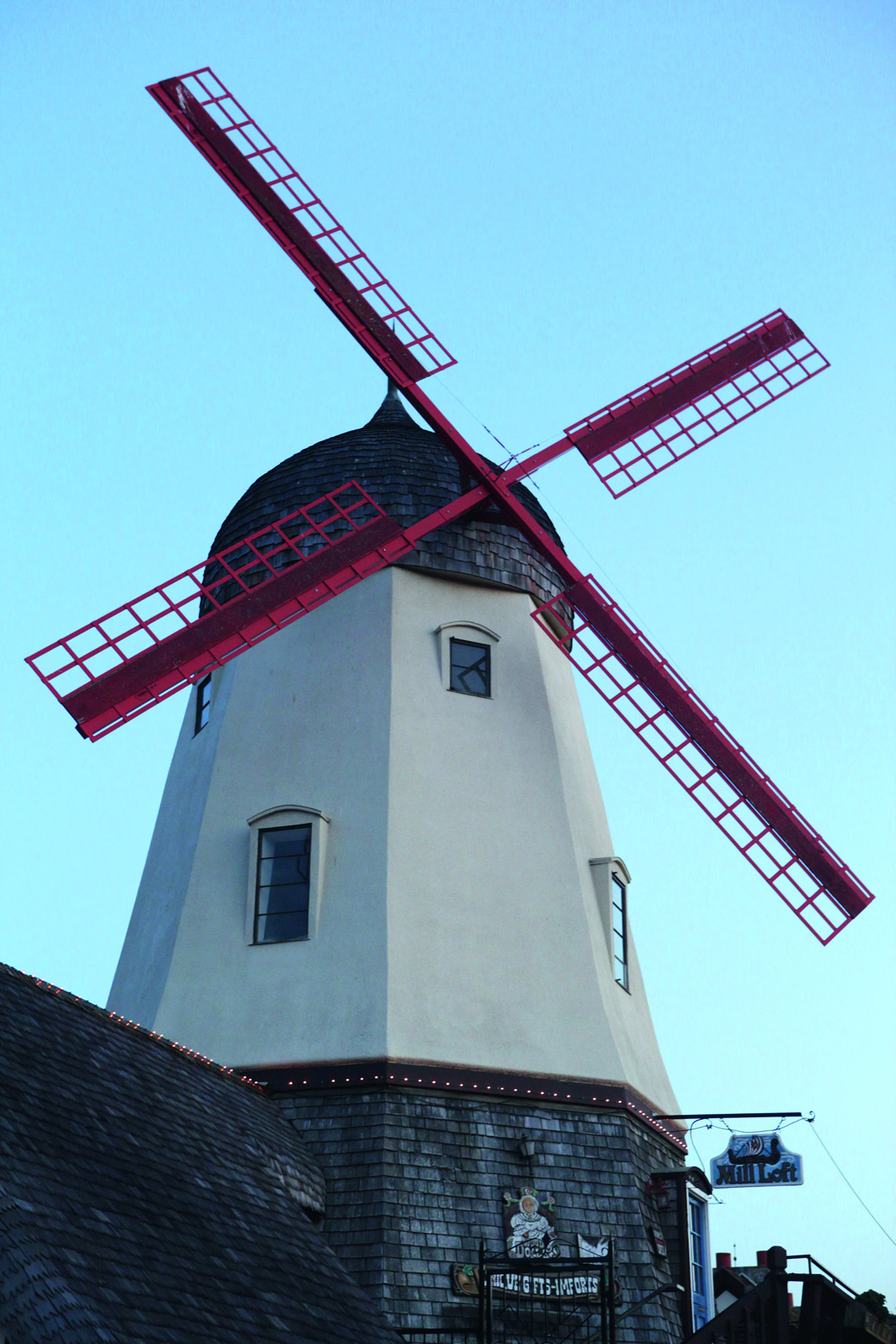
Windmill in Solvang, the town founded by a group of Danes and built to resemble a Danish settlement.
David Dunai/Apa Publications
Pismo Beach is famous for its clams, which can grow to almost 8ins (20cm), but they’ve almost disappeared because of overharvesting. Nevertheless, a Clam Festival is still held every October. If you want to try clamming, you must have a salt-water fishing license and a caliper to ensure they are of legal size (minimum 4.5ins (11.5cm). The limit is 10 per day and they can only be taken between a half-hour before sunrise and a half-hour after sunset.
From late November through February, hordes of colorful Monarch butterflies come to winter in groves of eucalyptus and Monterey pines. The groves are accessible from State Highway 1 at the southern city limits of Pismo Beach (daily guided walks 11am and 2pm).
Santa Ynez and Santa Maria valleys
Napa and Sonoma may be the best-known wine-producing regions in California, but the emerging and increasingly well-regarded Santa Ynez and Santa Maria valley wineries are well worth a visit. Spotlighted in the movie Sideways, the rural region is home to 100-plus wineries, including the high-profile Firestone Vineyard (tel: 805-688-3940) and the Fess Parker Winery (tel: 805-688-1545). For a current list of local wineries and information on their tours and tastings, contact the Santa Barbara County Vintners’ Association (tel: 805-688-0881; www.sbcountywines.com).
One of this Wine Country’s most notable towns is Solvang 4[map], an amusing and slightly camp replica of a Scandinavian town with horse-drawn streetcars, windmills, and Danish bakeries. The Hans Christian Andersen Museum (The Book Loft Building, 1680 Mission Drive; tel: 805-688-2052; daily 10am–5pm; free) has first, early, and illustrated editions of Andersen’s works and original photographs and letters. To learn more about the history of Solvang and heritage of Denmark, visit the Elverhoj Museum (1624 Elverhoy Way; tel: 805-686-1211; www.elverhoj.org; Wed–Thur 1-4pm, Fri–Sun noon-4pm; free).
Tip
On man-made Cachuma Lake in the Santa Ynez Valley, there are guided cruises led by park naturalists (Fri–Sun); in winter you can view a rare flock of migrating bald eagles; in spring and summer, resident birds can be seen building their nests.
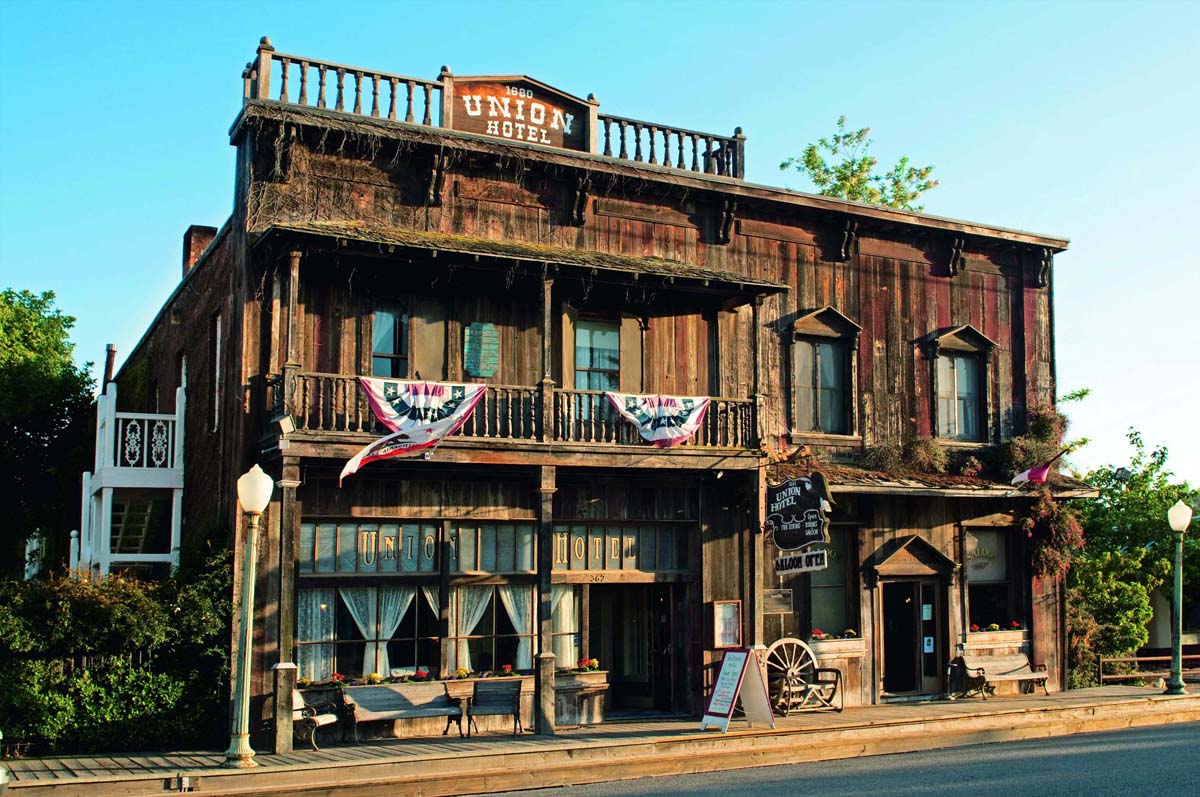
1880 Union Hotel, Los Alamos.
Steve Hamblin/Alamy

Danish-style Solvang.
David Dunai/Apa Publications
Continuing south on US 101, the highway skirts past gorgeous beaches before passing through Goleta, home of a University of California branch, and then arriving in Santa Barbara.
Santa Barbara
Beautiful Santa Barbara 5[map] first found admiration as a health resort in the 1870s after New York journalist Charles Nordhoff glowingly touted its mineral springs. The sunny “American Riveria” is still an alluring getaway destination, boasting a Mediterranean climate, picturesque white stucco buildings topped with red-tiled roofs, and 5 miles (8km) of palm-tree-lined beaches, perfect for leisurely jogging, biking, rollerblading, and sunbathing.
One of the shore’s main landmarks is the century-old Stearns Wharf A[map], the oldest pier on the West Coast. Here visitors choose among seafood stands, restaurants, wine tasting, fishing, and the Ty Warner Sea Center (211 Stearns Wharf:; tel: 805-962-2526; www.sbnature.org; daily 10am–5pm; charge), where local jellyfish mesmerize visitors with their graceful undulations, and small sharks patrol a touch pool.
If you are looking for larger marine life, whale-watching boat trips depart from Stearns Wharf most days from February through September. They are out to spot the heavyweight mammals heading north from the Baja coast with their offspring.
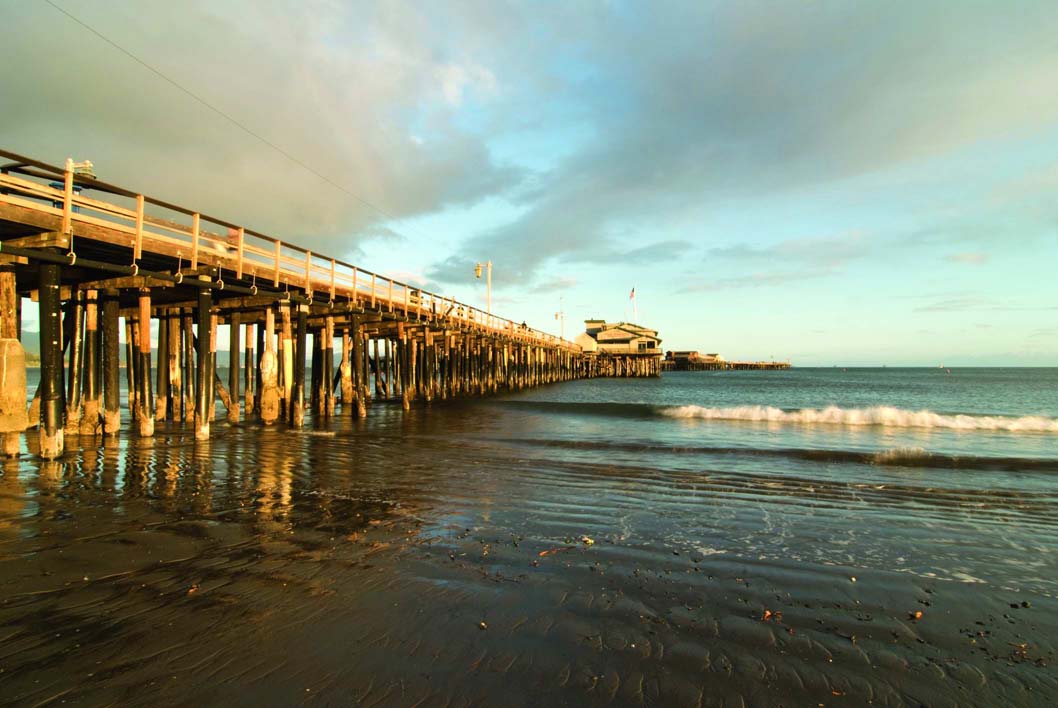
Stearns Wharf, Santa Barbara.
Take a short diversion to Chapala and Montecito streets to admire the massive Moreton Bay fig tree B[map], native to Australia and said to be the largest of its kind in America. Planted here in 1914, its branches have since grown to cover, at their widest spread, a length of 160ft (49 meters) and often shade the city’s down-and-out homeless community. A bit further along the harbor is the Santa Barbara Maritime Museum, with its ship models and floating exhibits.
For some beach life, Stearns Wharf is lined on either side with volleyball-court-filled beaches; East Beach is the long stretch of sand alongside Chase Palm Park, with showers, picnic facilities, and a playground.
Further down the eastern end of the shore, expensive hotels and the multicolored 21ft (6-meter) high Chromatic Gate stand on the waterfront. The latter was the work of Herbert Bayer, last survivor of the seminal Bauhaus school, who spent the years before his death in the town. Nearby, the petite Santa Barbara Zoo (500 Ninos Drive; tel: 805-963-5693; www.sbzoo.org; daily 10am–5pm; charge) houses 160 species – including gorillas, snow leopards, tropical birds, and giant anteaters – along with a small train and a petting zoo.
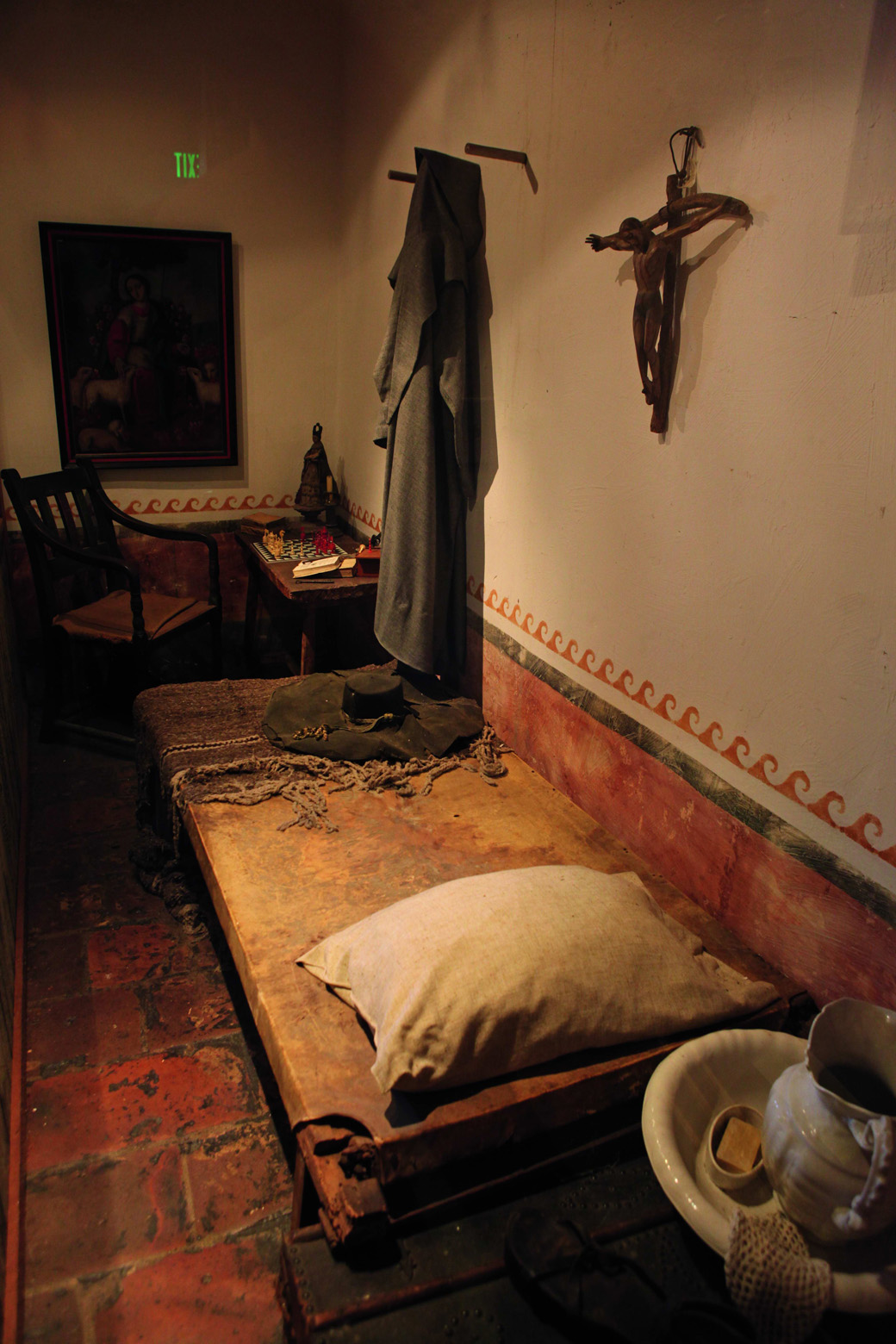
Museum exhibit at Mission Santa Barbara. The Mission is still home to a group of Franciscan friars, and has a retreat center as well as the church and museum.
David Dunai/Apa Publications
To explore downtown Santa Barbara, head up State Street, the main thoroughfare running northwest from the coast through Downtown. Turn right at E. De La Guerra Street to admire the Casa de la Guerra C[map] (1827), the original home of the Presidio’s commander and his family. Here the city council first met in 1850, an event still celebrated every August with a fiesta. The enticing cobbled area, El Paseo (“the street” in Spanish), is an attractive place to shop and sip coffee at outdoor cafés around the fountain.
The next block of E. De La Guerra, bordered by the Canedo Adobe (1782), is where the city began, centered around the Presidio D[map] with its chapel, restored adobes, and the Historical Society Museum. Continue up Anacapa Street and turn right on Carrillo to visit the Hill-Carrillo Adobe. The city’s first home with a wooden floor, it was built by Daniel Hill in 1826 for his Spanish bride.

Spanish-Moorish style of Santa Barbara’s Court House.
David Dunai/Apa Publications
Further up Anacapa is the handsome 1929 Spanish-Moorish Court House E[map] (1100 Anacapa Street; tel: 805-962-6464; Mon–Fri 8am–5pm, Sat–Sun 10am–4.30pm; free). Admire the lobby’s mosaics and murals, then take the elevator up to the tower for a lovely view of gently sloping roofs and the multilevel lawn below. The Santa Barbara Public Library is around the corner on Anapamu Street and the Museum of Art is close by on State Street.
A short drive up State Street and right on E. Los Olivos Street brings you to Mission Santa Barbara F[map] (Laguna and Los Olivos streets; tel: 805-682-4149; www.santabarbaramission.org; daily 9am–5pm; charge), one of the most beautiful of the remaining missions. Founded in 1786, it was damaged in both of the area’s major earthquakes (1812 and 1925) but lovingly restored, and is still in use as a parish church. The museum displays relics from the days when Chumash Indians lived and worked at the mission.
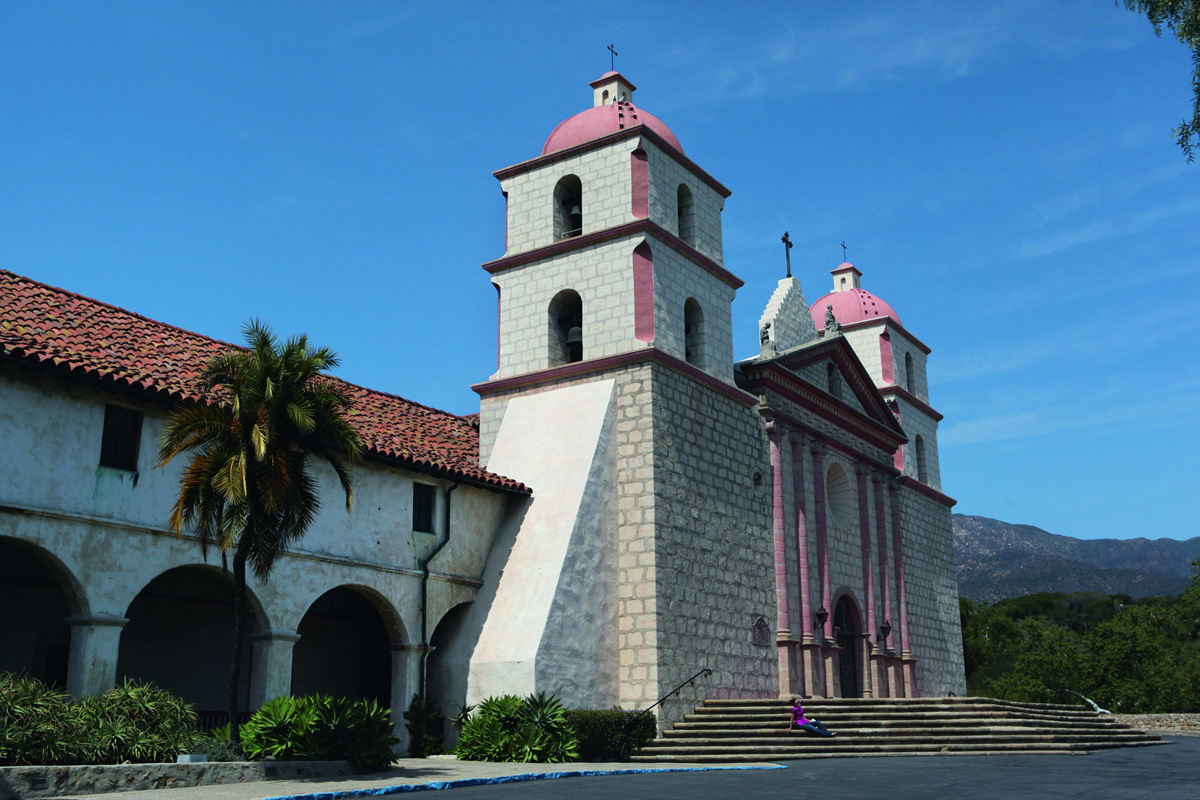
Mission Santa Barbara.
David Dunai/Apa Publications
Just two blocks north, the Museum of Natural History G[map] (2559 Puesta del Sol; tel: 805-682-4711; www.sbnature.org; daily 10am–5pm; charge), shares more about Native American and in particular Chumash life, and also has collections focusing on animals, birds, reptiles, and fish. A mile to the north up Mission Canyon Road, trails at the Botanic Garden H[map] (tel: 805-682-4726) meander through 78 acres (32 hectares) of native flowers, shrubs, and cacti.
Ojai
Hidden away on the edge of the Los Padres National Forest, Ojai 6[map] (pronounced Oh-hi) is a sleepy but happy town full of artists and writers. From the Pacific Coast Highway, take Highway 30 for 15 miles (24km), or head inland 35 miles (56km) from Santa Barbara on highways 101 and 150.
Montecito
Just on the southern outskirts of Santa Barbara, Montecito has long been a good place to spot celebs. The charming Montecito Inn (tel: 805-969-7854; www.montecitoinn.com) was popular with refugees from Hollywood in the 1920s when one of its original owners was Charlie Chaplin.
Montecito’s other legendary hotel is San Ysidro Ranch (tel: 805-565-1700; www.sanisidroranch.com), where John F. Kennedy honeymooned with his wife, Jackie, and where Lauren Bacall says she fell in love with Humphrey Bogart. It is also the site of a midnight wedding in 1940 between Laurence Olivier and Vivien Leigh.
Today Butterfly Beach (at Olive Mill Road) is often frequented by celebrities; it lies across the street from the posh Biltmore Hotel.
On the main street, a graceful tower offsets a row of shops behind a covered arcade. The predominantly Spanish-style architecture owes its origins to glass tycoon Edward Drummond Libby, who in 1917 built the elegant Oaks Hotel opposite the library.
To see exhibits on the environmental, cultural, and historical factors that shaped the Ojai valley, visit the Ojai Valley Museum (130 W. Ojai Avenue; tel: 805-640-1390; www.ojaivalleymuseum.org; Tue–Sat 10am–4pm, Sun noon–4pm; charge). It is located in the St Thomas Aquinas Chapel (c.1918) and doubles as the Ojai Visitor Center.
Large annual events in Ojai include a spring tennis tournament, an arts festival in May, a classical music festival in June, and a film festival in October.
West of Ojai, you can take State Highway 150 to wind along some 60 miles (100km) of the shoreline of Lake Casitas, but the scenery is even better along the coast.
Channel Islands
One of the least visited of America’s national parks, the isolated Channel Islands are often called the “North American Galapagos.”
Over 150 endemic or unique species are found here, including the island fox, island spotted skunk, and island night lizard. The pygmy mammoth once lived here too, standing just 4–8ft (1–2 meters) high at the shoulders, compared to the 12–14ft (3.5–4-meter) -tall mainland mammoths. Separated from their mainland counterparts, these mammoths evolved as food scarcity put smaller animals at an advantage.
Today, 99 percent of Southern California sea birds nest and feed here, including bald eagles and peregrine falcons, while sea lions, whales, dolphins, and giant black sea bass swim in the surrounding waters.
Ventura and the Channel Islands
Just north of Los Angeles, Ventura is dominated by an ostentatious city hall perched on the hillside. The grand civic giant is outshone in style and grace, however, by the 230-year-old Mission San Buenaventura (211 E. Main Street; tel: 805-643-4318; www.sanbuenaventuramission.org) with its pretty garden. Founded in 1782 by Father Junípero Serra, it sits on the edge of a restored “Olde Towne” area filled with antiques shops.
Ventura also serves as a main departure point for the Channel Islands National Park 7[map]. The only national park in Southern California, it encompasses the Anacapa, Santa Cruz, San Miguel, Santa Rosa, and Santa Barbara islands. The beautiful and desolate Santa Barbara Island is especially popular, with its 640 acres (260 hectares) offering a haven for birds, sea lions, and seals. For trip-planning help, visit the National Park Service Visitors Center (1901 Spinaker Drive; tel: 805-658-5730; www.nps.gov/chis/index.htm).
Tip
The Downtown–Waterfront Shuttle provides frequent service along State Street and the Waterfront area. Shuttle buses and bus stops are marked with blue and black sailboat symbols and the shuttles travel on State Street from Sola Street to Stearns Wharf and along Cabrillo Boulevard. The shuttle fare is 25 cents one-way. State Street service stops every block and runs daily every 10 minutes (10.15am–6pm).
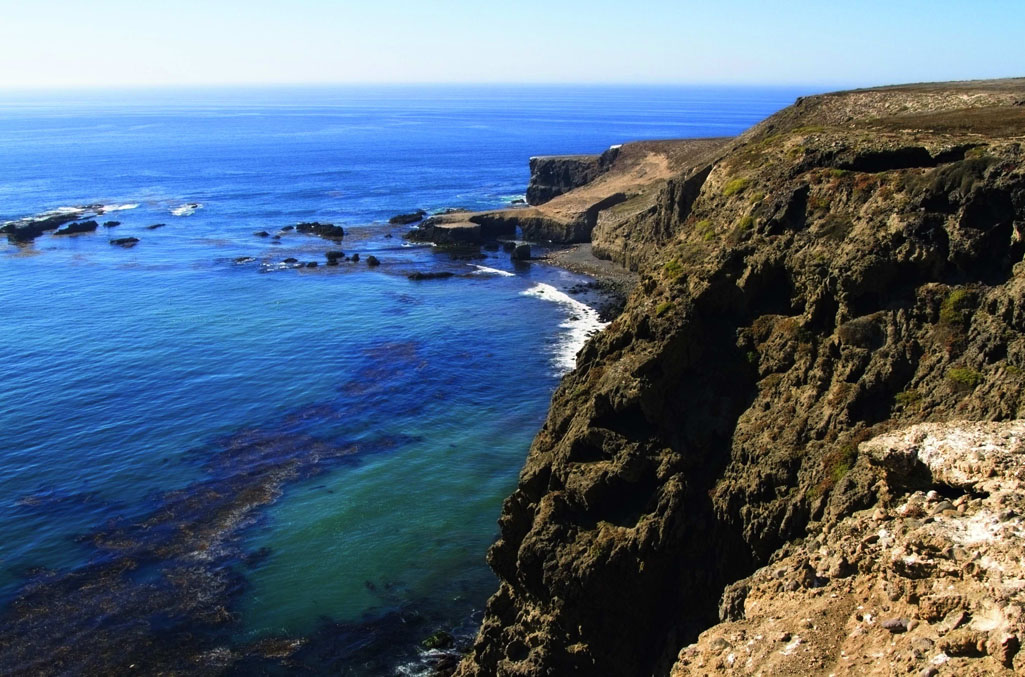
Webster Point area of Santa Barbara Island.
Michele Wassell/Superstock
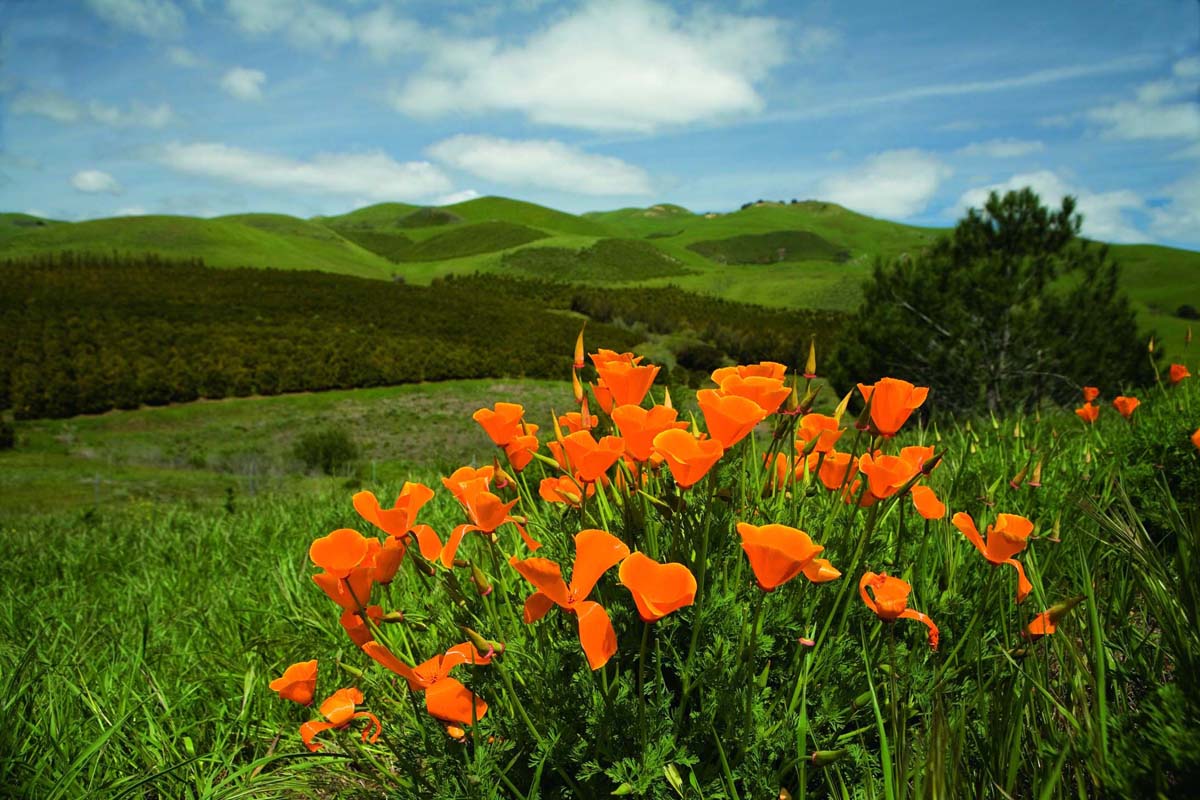
Wildflowers bloom on a central Californian hillside in the spring.
David Dunai/Apa Publications

